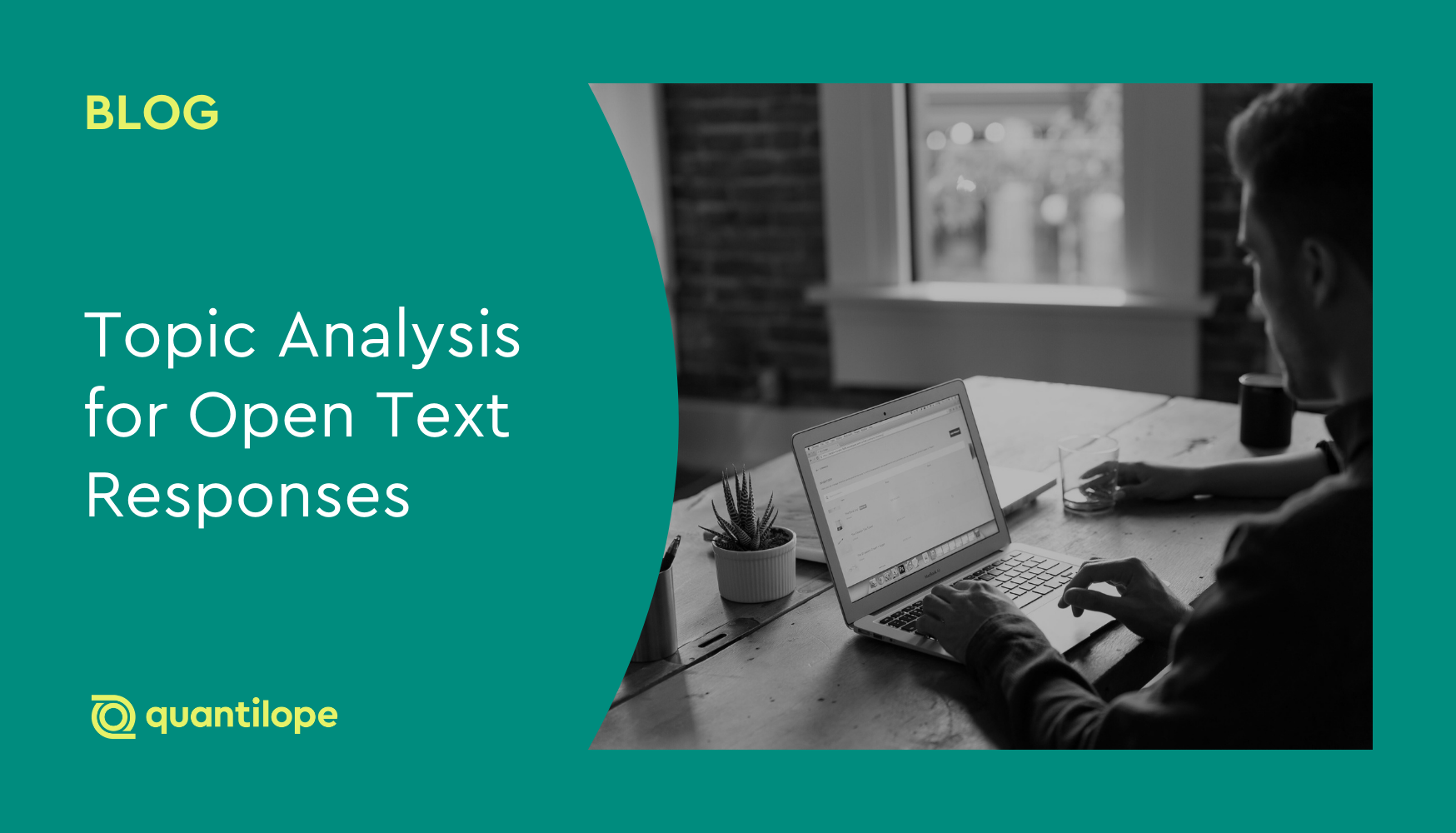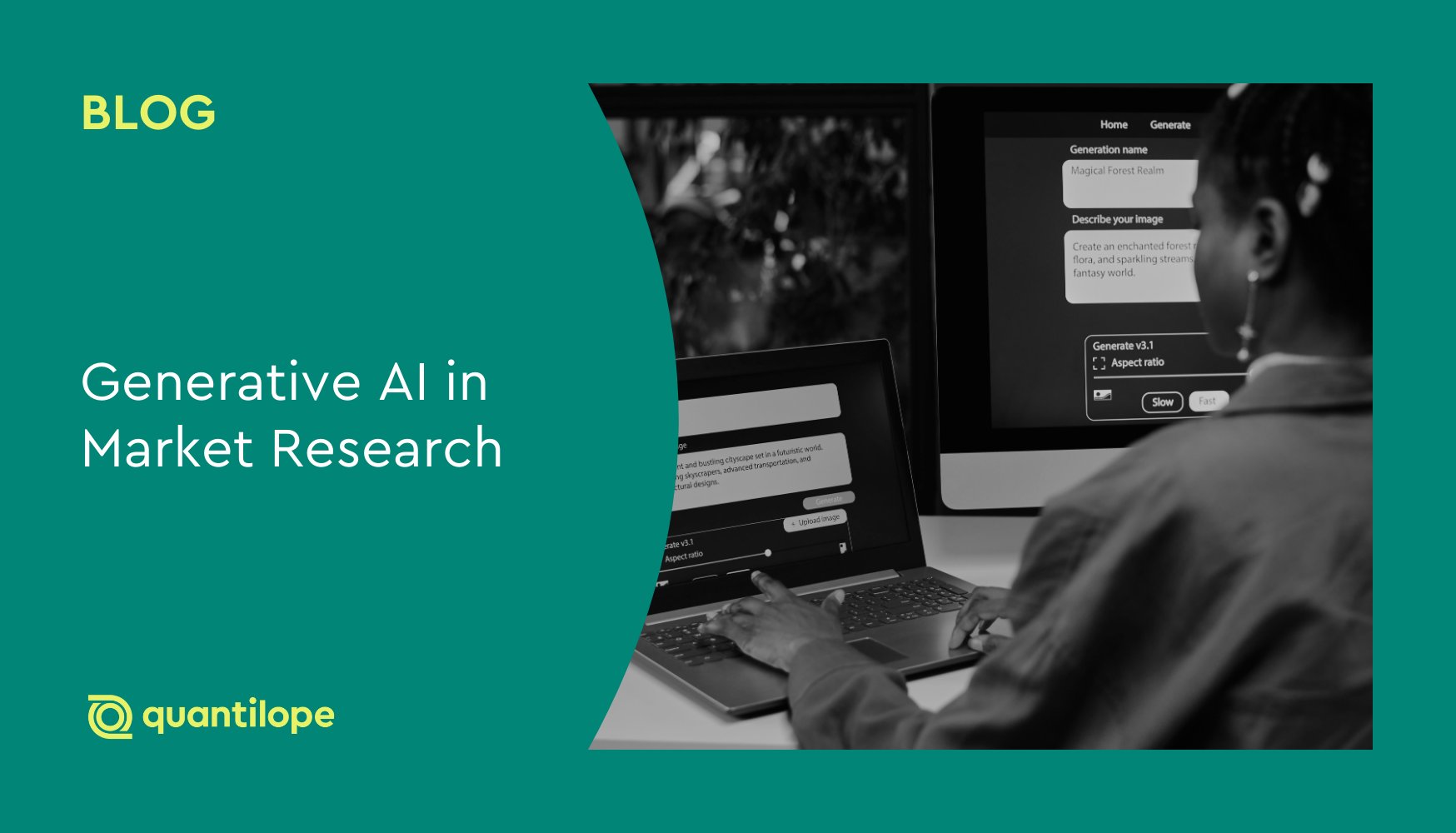This blog explores one of quantilope’s text analytics capabilities: Topic Analysis - including what it is, when to use it, and how it works.
Table of Contents:
- What is Topic Analysis?
- What are the use cases for Topic Analysis?
- How does Topic Analysis work?
- What are the benefits of using Topic Analysis?
- What other text analytics does quantilope offer?
- One-stop shop for consumer insights
What is Topic Analysis?
Topic Analysis is one of quantilope's data visualization tools for analyzing and interpreting open-end responses. The analysis automatically organizes open-text feedback into categories, topics, or themes, making the results easily digestible. Topics/themes that got a lot of responses will appear larger in the overall chart, while more unique answers will take up smaller space - creating a visually intuitive way of interpreting consumer feedback.
quantilope's Topic Analysis requires no manual coding, can work across 30+ languages without having to apply any language settings, and can be customized however needed (i.e. changing a topic's color or label). While the output is advanced and highly actionable as is, platform users also have the option to add or remove any topics they feel necessary.
Back to Table of Contents
What are the use cases for Topic Analysis?
quantilope’s Topic Analysis works especially well for open-ended text questions that require some detailed responses. It’s best used in cases where participants respond with short sentences or even longer form paragraphs, rather than single words or phrases.
For example, a brand running a concept test might want to ask its participants to describe their reaction to a new type of packaging. These responses would include longer sentences such as ‘I really like the colors of the packaging because it catches my eye’, or, ‘I wish the font was bigger because my eyesight is rather poor and it’s hard for me to understand what the product is offering’. In this case, Topic Analysis would be able to dissect and organize these longer sentences into topics for easy analysis.
Another use case might be a brand asking participants to describe their recent shopping experience at their store. Participants could go into detail about how the store was laid out, how easy it was to find things, how much support they got from store employees, how loud the music was, or how convenient it was to find a parking spot. Participants will have all sorts of different experiences, so being able to cluster their experiences through Topic Analysis is hugely beneficial to researchers and brands.
The more popular topics will take up larger area in the chart. So let's say a lot of shoppers found the store to be really clean, saying things like 'the store is kept very nice' or 'love how clean the aisles are at this location'. Meanwhile, just one or two provided feedback that they 'liked the music choice playing on the store speakers'. The chart would show 'cleanliness' in a larger-sized square of the chart than 'music'.
Back to Table of Contents
How does Topic Analysis work?
Using machine learning (ML) and natural language processing (NLP), Topic Analysis clusters open-ended answers into overarching groups with similar meanings - providing brands with an understanding of the content of hundreds or even thousands of answers in just a few seconds.
Brands can leverage this analysis for any open-ended question in their survey. When triggered, quantilope’s algorithm clusters the answers into overarching groups with similar meanings and visualizes the results in a comprehensive and customizable treemap chart (as shown below). Unlike other vendors that source this data out to third parties for analysis, all these steps happen in just a few seconds directly on quantilope’s platform.
For example, a candy brand might ask their target audience what they liked about their products, and participants would respond with detailed sentences. From these text responses, quantilope’s platform will extract the most commonly cited themes such as ‘chocolate’, ‘packaging’, ‘sugar-free options’, ‘mint’, ‘brand’, and ‘great taste’, as shown below:
Once the Topic Analysis is finished, the identified topics can be reviewed and fine-tuned directly in the app. For example, this candy brand might want to rename the ‘Mint’ category to ‘Peppermint’ which more accurately defines their product type. Brands also have the option to reassign topics to individual participant answers after taking a closer look.
Back to Table of Contents
What are the benefits of using Topic Analysis?
Reviewing verbatim answers can be a lengthy process, especially without automated tools to filter out gibberish or poor-quality responses - but that shouldn’t be a reason that brands don’t capture open-ended feedback.
At quantilope, we understand the importance of verbatim feedback directly from the mouths of consumers and developed a simple way for brands to capture and analyze these insights. Topic Analysis speeds up the path to insights by eliminating the need to manually review answers to open-ended questions, leaving it all to machine learning on the backend. In addition to speed, Topic Analysis produces actionable data visualizations and is fully customizable.
Back to Table of Contents
What other text analytics does quantilope offer?
Topic Analysis is just one way to go about analyzing and interpreting open-ended responses from survey participants.
Word Count Analysis
quantilope’s word count analysis provides a quick and comprehensive overview of the most commonly used words in an open-ended question. This is a simpler form of analysis than Topic Analysis since it only counts how often a particular word has been mentioned across all responses without taking into account semantic similarity and the context of responses (like Topic Analysis does). This is a great analysis to use when there is little ambiguity in text responses, such as the name of a brand, single-word descriptions, or other categorical responses.
Word count analysis results can be viewed in bar chart form, showing the top 10 words (by default, but of which are customizable), or can be visualized in a word cloud, which displays words in a cloud formation with the top-mentioned words shown in a larger font. Regardless of how results are visualized, word count analysis can analyze text from phrases, parsing out filler words like ‘the’, ‘and’, etc. It’s great to use when attempting to understand consumer opinions in their own words/language.
Keyword Analysis
For a more detailed analysis of unaided brand awareness questions, quantilope also offers a keyword analysis. Keyword analysis allows brands to enter their own words of interest to be accounted for. While word count analysis can identify misspellings of common words such that ‘cocolate’ would be counted as ‘chocolate’, it still displays similar forms of brand names (such as Hershey vs. Hershey’s) as separate words rather than aggregating them together. This is where keyword analysis comes in, allowing brands to count very similar forms of brand names as one.
Aside from iterations of brand names, keyword analysis can also be used to track other mentions that might not come to light in standard word count analysis. For example, if a brand launched a new slogan such as Almond Joy’s ‘tropi-calling’, the brand could add different iterations to the keyword list such as ‘tropical calling’ or just ‘tropical’ to also be counted as a mention of the phrase.
Further, keyword analysis is a real game changer for tracking studies, providing a real-time glimpse into unaided brand awareness without any need for manual data analysis or coding. Comprehensive tracking charts can be shared in your dashboard to let your team and stakeholders stay on top of your brand health and see how mentions are trending over time.
Back to Table of Contents
One-stop shop for consumer insights
Text analytics form just one dimension of quantilope’s end-to-end research platform. Exporting text data to an external open-ended analytics platform, manually coding text, and uploading findings to a third platform just to share it with stakeholders is an outdated approach to research. With quantilope’s end-to-end platform, brands get a one-stop shop for all research needs so they can focus their time on the insights and the story, not the tedious file formatting and manual calculations.
With quantilope, all insights are calculated and shown in real-time as soon as the first participant completes - even as the survey is still live for others. With this feature, brands can start to analyze and save charts to a report, all of which integrate into a final insights dashboard. As new completes come in, these charts update automatically with the latest data, empowering teams, clients, or stakeholders to always have the most updated results right at their fingertips.



.png)
